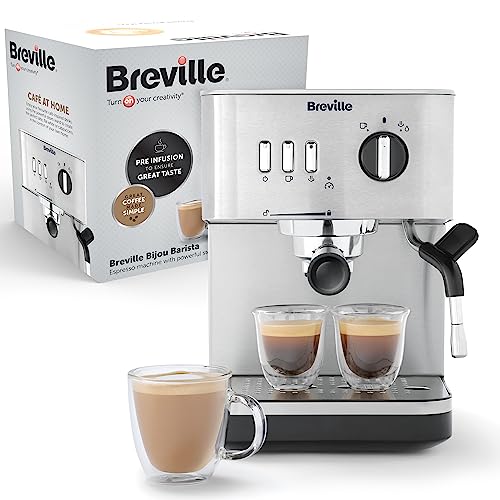How to Maintain Espresso Machines
Espresso drinks can be an excellent addition to businesses such as hair salons, doctors' offices, and car dealerships. Providing these gourmet drinks will increase the patience of customers when waiting for service and improve the ambience of your establishment.
A Good Housekeeping 2022 Espresso Machine winner, this machine uses a smart dosing system to weigh and disperse the perfect amount of ground coffee for each shot. It also includes a milk frother that performed well in our tests.
The Basics
Espresso machines are an excellent addition to any office or home. They can be used for numerous drinks, including lattes or cappuccinos. They work by forcing hot water through ground coffee under pressure. This creates an intense shot of coffee that is extremely tasty. It also has a significant level of caffeine which can be a powerful stimulant.
These machines are available in a vast range of sizes, starting with small models for domestic use to larger models to serve commercial needs. They are available in semi-automatic and manual versions. Semi-automatic models have a built-in pump that controls the water's flow and pressure. Manual machines require that you control this manually. Certain semi-automatic models feature grinders while others do not. The kind of machine you decide to purchase will be based on your personal preferences and budget.
Manual espresso machines work by allowing the user to turn a handle to push water through grounds that have been put in a basket for filtering. This type of machine, also known as a caffettiera or macchinetta is the most well-known model of espresso maker. It includes a lower chamber that holds the water and a top chamber that houses a metal filter. When it is heated the steam from the water is pushed through the grounds, and finally into the top chamber, where the brewed espresso is ready to serve.

Varieties
There are various types of espresso machines based on your requirements. There are manual, semi-automatic and fully automated espresso machines. Each machine has its own distinctive way of producing espresso shots as well as other drinks like cappuccinos and lattes.
The first machines weren't fully automated. They required the user to manually operate the lever to generate the pressure needed to pull an arrow. They are still in use however they are not as frequent due to the amount of effort required and the stress they can cause. Modern espresso machines make use of various mechanisms to generate pressure, including push, screw and see-saw designs. This allows the user to manage pre-infusion and water volume more precisely than the lever machine.
A pump-driven espresso machine is akin to the moka pot on the stove, however, it uses an electric pump instead of steam to press the grounds. The boiler heats the water to boiling point, and a pump then forces the water through a group head. They are the most well-known types of espresso machines and are generally less expensive than other varieties.
Semi-automatic espresso machines bring together the best characteristics of pumps-driven and manual espresso machines. They let the user grind and tamp the beans but a motor regulates the pressure to ensure consistency during extraction. They also come with a separate compartment that is heated and froths milk and some are equipped with an integrated grinder.
Functions
Commercial espresso machines can make a broad range of coffees, which includes espressos, all at the push of one button. They use pre-packaged pods which are precisely dosed and packaged to make one cup of espresso or coffee. These machines are extremely popular in busy offices due to the fact that they eliminate the necessity of a grinder as well as dosing and tamping. However, since they also lack steam functions, you'll require separate milk frothers to make cappuccinos and lattes.
Many cafes in Europe utilized steam machines to boost production and speed up brewing. However, these early machines were heated by an open flame, resulting in inconsistent temperature and pressure. Inventor Angelo Moriondo of Turin, Italy is credited with developing the first machine capable of brewing espresso without using steam.
The most popular type of machine today is the pump-driven espresso machine. They are equipped with a porta-filter in which ground espresso beans are inserted. When the valve is set to the espresso position, the water is pumped under 15 atmospheres pressure from the heating vessel. When the brew cycle is completed, the porta-filter is removed and the drip tray is emptied to clean.
Automated espresso machines add automation to semi-automatic systems through controlling the extraction time in accordance with volumetric or internal timers. They also take away the barista's ability to tamp or grind coffee, which impacts the quality of the finished product.
Maintenance
Espresso machines might not be the most attractive equipment in a cafe, but they are extremely important. How you maintain the espresso machine will impact the taste and quality of your drinks.
A clean espresso machine will ensure the flavor of your coffee isn't compromised and your customer's experience is excellent. Regularly scheduled cleanings can extend the life of your espresso machine.
Clean home espresso machine as well as the baskets at least once per shift using a damp cloth to get rid of residue and oils left behind. During this time, backflush gasket for the portafilter (the seal between the portafilter's seal and the group head) by inserting a brush made of nylon into the gasket and moving it around to eliminate any accumulation. Rinse off the gasket then run it again until the water is clear.
Mix espresso machine cleaner with water in a container according to the directions of the manufacturer at least once a week or as needed. Then soak the portafilters as well as the baskets in the cleaning solution overnight. If your espresso maker comes with a steam wand or screen, remove them from the entire group with a screwdriver. In separate soaking, soak them in the cleaning solution.
